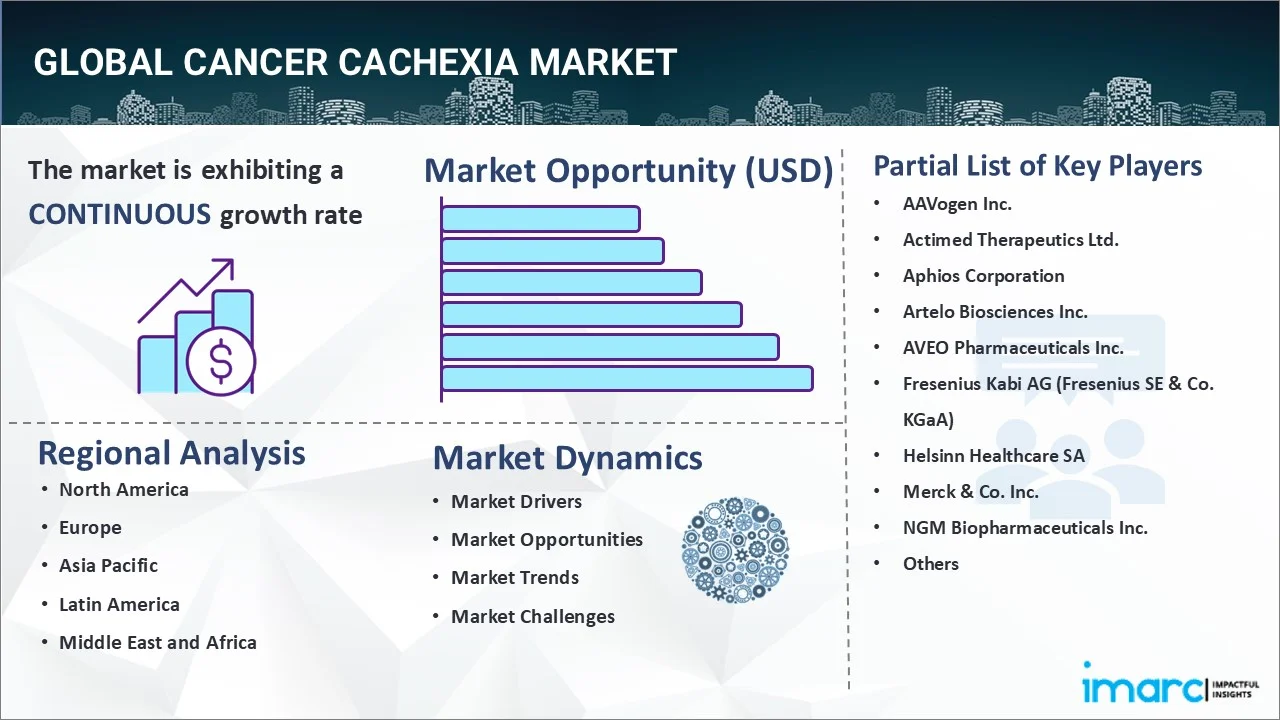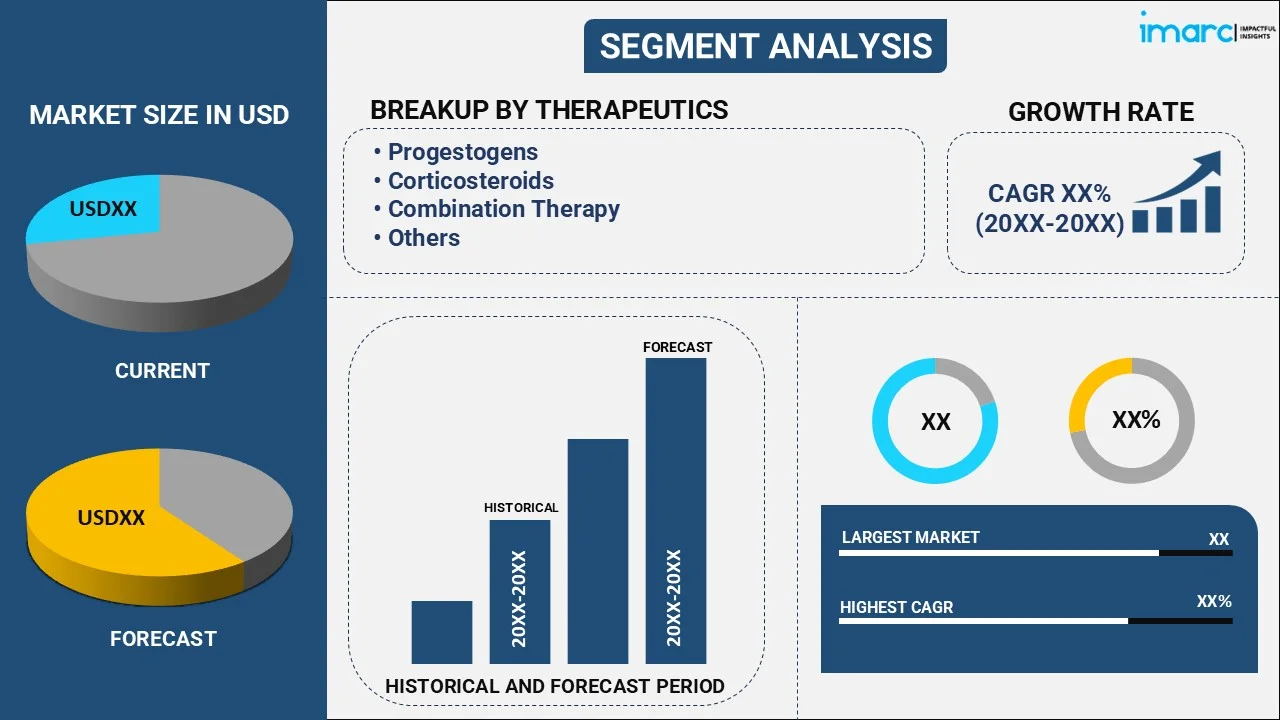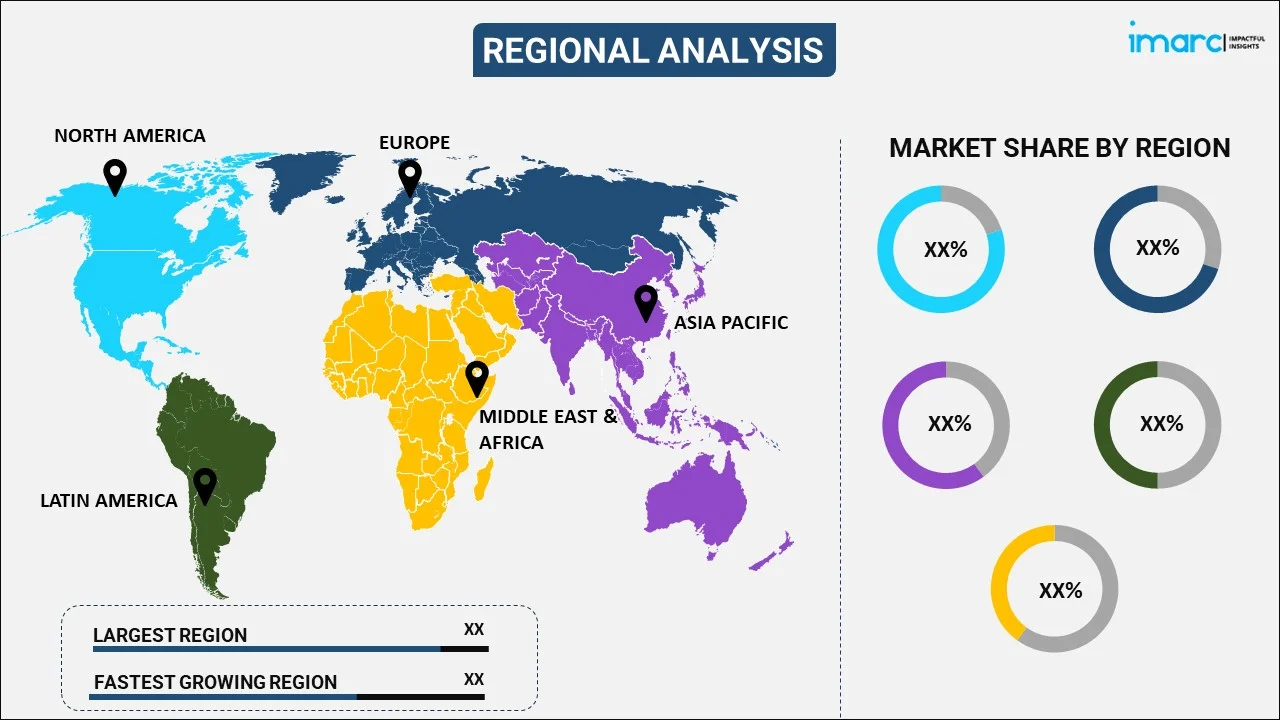
Cancer Cachexia Market Report by Therapeutics (Progestogens, Corticosteroids, Combination Therapy, and Others), Mode of Action (Appetite Stimulators, Weight Loss Stabilizers), Distribution Channel (Hospital Stores, Retail Pharmacy, Online Pharmacy), and Region 2025-2033
Cancer Cachexia Market Size:
The global cancer cachexia market size reached USD 2.2 Billion in 2024. Looking forward, IMARC Group expects the market to reach USD 3.0 Billion by 2033, exhibiting a growth rate (CAGR) of 3.9% during 2025-2033. The market is driven by the rising global cancer incidence, the growing recognition of cachexia's significant impact on patient outcomes, and increased research into targeted therapies, all of which aim to enhance patient quality of life and treatment effectiveness.
|
Report Attribute
|
Key Statistics
|
|---|---|
|
Base Year
|
2024
|
|
Forecast Years
|
2025-2033
|
|
Historical Years
|
2019-2024
|
|
Market Size in 2024
|
USD 2.2 Billion |
|
Market Forecast in 2033
|
USD 3.0 Billion |
| Market Growth Rate 2025-2033 | 3.9% |
Cancer Cachexia Market Analysis:
- Major Market Drivers: The cancer cachexia indsutry is propelled by the increasing prevalence of cancer globally, an aging population, and heightened awareness and understanding of the debilitating impact of cachexia on cancer patients.
- Key Market Trends: There is a growing focus on the development of multimodal therapies that combine nutritional support, medications, and physical therapy. Advances in understanding the molecular mechanisms behind cachexia are also driving targeted therapeutic interventions.
- Geographical Trends: North America and Europe lead in market size due to high healthcare spending, advanced medical research facilities, and greater awareness among healthcare providers and patients. Emerging markets in Asia are experiencing rapid growth due to increasing cancer diagnoses and improving healthcare infrastructures.
- Competitive Landscape: Some of the major market players in the cancer cachexia industry include AAVogen Inc., Actimed Therapeutics Ltd., Aphios Corporation, Artelo Biosciences Inc., AVEO Pharmaceuticals Inc., Fresenius Kabi AG (Fresenius SE & Co. KGaA), Helsinn Healthcare SA, Merck & Co. Inc., NGM Biopharmaceuticals Inc., Pfizer Inc. and Tetra Bio-Pharma, among many others.
- Challenges and Opportunities: A major challenge is the complexity of cachexia’s pathophysiology, making treatment development difficult. However, this also presents an opportunity for breakthrough therapies and integrated care approaches that can significantly improve patient quality of life and outcomes.

Cancer Cachexia Market Trends:
Increased Focus on Nutritional Interventions
A growing body of research highlights the importance of nutritional support in the management of cancer cachexia and its impact on patient outcomes. The American Cancer Society and other organizations emphasize the significance of individualized dietary therapies in preventing weight loss and muscle atrophy in cachectic patients. According to research, adding specific nutritional supplements and dietary guidance can greatly enhance patients' quality of life and possibly increase their chances of survival when they have cachexia. As more healthcare practitioners embrace comprehensive treatment plans that cover both the oncological and metabolic facets of cancer care, this movement is accelerating the cancer cachexia market demand.
Advancement in Pharmacological Research
A significant trend in the market is the advancement of pharmacological medicines that specifically target the metabolic pathways implicated in cancer cachexia. The National Cancer Institute reports that several clinical trials are investigating the effectiveness of medications such as enobosarm and anamorelin. The goal of these trials is to modify the hormones and inflammatory responses associated with cachexia to prevent muscle atrophy and enhance physical function. If these medications are approved and made available for use, the therapeutic landscape may change, and doctors may have new tools to better treat the symptoms of cachexia. The industry's dedication to treating this complicated illness is further demonstrated by the expanding collaboration between university research institutes and pharmaceutical firms, which is stimulating innovation and accelerating the development of efficient cachexia medicines.
Rising Prevalence of Cancer Worldwide
The market for cancer cachexia is primarily driven by the rise in cancer incidence worldwide. According to the World Health Organization (WHO), within the next 20 years, there will likely be a 70% increase in cancer incidence, which will greatly increase the number of people who are likely to experience cachexia. To improve patient outcomes and quality of life after cancer treatment, this spike calls for more focus and investment in cachexia management measures, such as early diagnosis, detailed treatment programs, and supportive care services. This requirement is further heightened by the aging population that is spreading throughout the world and is more prone to cancer. This has changed the cancer cachexia market outlook for the industry and patients across the globe.
Cancer Cachexia Market Segmentation:
IMARC Group provides an analysis of the key trends in each segment of the market, along with forecasts at the global, regional, and country levels for 2025-2033. Our report has categorized the market based on therapeutics, mode of action, distribution channel.
Breakup by Therapeutics:

- Progestogens
- Corticosteroids
- Combination Therapy
- Others
Progestogens accounts for the majority of the market share
The report has provided a detailed breakup and analysis of the market based on the therapeutics. This includes progestogens, corticosteroids, combination therapy, and others. According to the report, progestogens represented the largest segment.
Progestogens are the market leaders in cancer cachexia mainly due to their ability to increase appetite and encourage weight gain in patients. According to clinical trials and studies recognized by the National Cancer Institute, demonstrate that progestogens, such as megestrol acetate, are frequently used to prevent substantial weight loss in cancer patients. This transient improvement in symptoms is achieved. Studies show that these hormones can dramatically enhance appetite, leading to weight gain that is mostly composed of fat instead of lean body mass. Their use is essential in improving patients' functional status and quality of life, even though they are not a cure for cachexia. This is especially important for patients undergoing rigorous cancer therapy.
Breakup by Mode of Action:
- Appetite Stimulators
- Weight Loss Stabilizers
Weight loss stabilizers holds the largest share of the industry
A detailed breakup and analysis of the market based on the mode of action have also been provided in the report. This includes appetite stimulators and weight loss stabilizers. According to the report, weight loss stabilizers accounted for the largest market share.
As they play a critical role in controlling and reducing the progressive weight loss that cachexia patients experience, which has a direct influence on their quality of life and survival rates, weight loss stabilizers are the market leader in cancer cachexia. As per studies reported by the National Cancer Institute, stabilizing weight in cachectic individuals has been linked to better results and can greatly increase survival periods. These drugs function by going after the metabolic abnormalities that cause the breakdown of fat and muscle tissue, which is a frequent side effect in later stages of cancer. In order to preserve muscle mass and physical strength, the focus on weight stabilization includes not only pharmacological therapies but also nutritional support and physical therapy.
Breakup by Distribution Channel:
- Hospital Stores
- Retail Pharmacy
- Online Pharmacy
The report has provided a detailed breakup and analysis of the market based on the distribution channel. This includes hospital stores, retail pharmacy and online pharmacy.
Hospital stores are the major distributors of specialized nutritional and medical products within the cancer cachexia market. They give immediate access to the products that assist in massive weight loss and muscle atrophy. Being within hospitals, these stores provide a direct and continuous line for patients, making the supply chain of cancer healing more specialized. The direct line shortens the cancer healing period by enabling a constant supply of care. Since the products are being sought after close to the hospital, there is a promise of rapid action by the healthcare provider as the source of supply is within his reach. Thus, hospital stores are an opportunity to integrate the process of managing cachexia and promise the cancer cachexia market growth.
As per the cancer cachexia market report, the retail pharmacy represents a significant distribution channel. Its importance is mainly based on providing direct access to the required medications and nutritional supplements. These are of fundamental interest for treating this disease primarily due to the need to combat such common symptoms as an excessive loss of weight and muscle tissue. In this context, retail pharmacies can guarantee almost immediate access to the supportive care chemotherapy treatments that are crucial for patients with cachexia requiring ongoing care. This approach will ensure the optimal performance of any therapeutic course due to the continuity of care, which is also one of the key factors in improving the quality of life of affected patients. Therefore, the pharmacy network should also play a significant role in ensuring the availability of the necessary course of therapy, making it closer to both patients and their careers.
Online pharmacies drives the cancer cachexia market recent opportunities by ensuring patients have access to specialized medication and supplements. Symptomatic medication and palliative substances aimed at combating the negative effects of the condition, including extreme weight and muscle loss, are not always available in conventional pharmacies and require more straightforward access. In addition, online pharmacies deliver the products directly to patients’ homes, eliminating the need for patients with reduced mobility or living in remote area to commute to the store. Finally, online pharmacies offer a discreet and judgment-free environment that allows patients with stigmatizing condition to receive necessary treatments without frequent pharmacy visits.
Breakup by Region:

- North America
- United States
- Canada
- Asia-Pacific
- China
- Japan
- India
- South Korea
- Australia
- Indonesia
- Others
- Europe
- Germany
- France
- United Kingdom
- Italy
- Spain
- Russia
- Others
- Latin America
- Brazil
- Mexico
- Others
- Middle East and Africa
North America leads the market, accounting for the largest cancer cachexia market share
The report has also provided a comprehensive analysis of all the major regional markets, which include North America (the United States and Canada); Europe (Germany, France, the United Kingdom, Italy, Spain, Russia, and others); Asia Pacific (China, Japan, India, South Korea, Australia, Indonesia, and others); Latin America (Brazil, Mexico, and others); and the Middle East and Africa. According to the report, North America represents the largest regional market for cancer cachexia.
As per the cancer cachexia market forecast, North America is dominated for several reasons, including its sophisticated healthcare system, high cost of care, and heavy emphasis on R&D. According to data from the National Institutes of Health, substantial investments are made in cancer research, including studies on cachexia, which facilitate the development of innovative treatments. In addition, the American Cancer Society forecasts that over 1.9 million new cases of cancer will occur in the region in 2023, which will increase the number of instances of cachexia and increase the need for efficient management strategies. The region also has a high incidence of cancer. Its position as the market leader for cancer cachexia forecast is further reinforced by the existence of eminent pharmaceutical companies and research institutes in North America as well as regulatory assistance for drug development.
Competitive Landscape:
- The market research report has also provided a comprehensive analysis of the competitive landscape in the market. Detailed profiles of all major companies have also been provided. Some of the major cancer cachexia companies include AAVogen Inc., Actimed Therapeutics Ltd., Aphios Corporation, Artelo Biosciences Inc., AVEO Pharmaceuticals Inc., Fresenius Kabi AG (Fresenius SE & Co. KGaA), Helsinn Healthcare SA, Merck & Co. Inc., NGM Biopharmaceuticals Inc., Pfizer Inc. and Tetra Bio-Pharma.
(Please note that this is only a partial list of the key players, and the complete list is provided in the report.)
- Through creative therapeutic developments and calculated partnerships, leading companies in the cancer cachexia market, including AAVogen Inc., Actimed Therapeutics Ltd., Aphios Corporation, Artelo Biosciences Inc., AVEO Pharmaceuticals Inc., and Fresenius Kabi AG, are actively pushing the boundaries of cachexia treatment. AAVogen Inc. is concentrating on employing gene therapy technology to alter the development and breakdown of muscle. ACM-001 is one of the specialty medications Actimed Therapeutics is developing to help people with cachexia gain more muscle mass and strength. Aphios Corporation is investigating the use of improved natural substances to help patients live better and control their symptoms. In a similar vein, Artelo Biosciences is working on developing cannabinoid-based treatments to treat the appetite problems and weight loss linked to cachexia. Targeted medicines addressing the molecular processes underlying muscle and weight loss have been developed by AVEO Pharmaceuticals. To address the peculiar dietary requirements of patients suffering from cachexia, Fresenius Kabi provides customized nutritional solutions that improve overall health results. These cancer cachexia market recent developments help in generating the cancer cachexia revenue in the long run.
Cancer Cachexia Market News:
- In August 2022: ARTHEx biotech launched ENTRYTM, a platform that will allow it to advance its pipeline of drugs that includes drugs for myotonic dystrophy, cancer cachexia, and osteoarthritis by providing tissue-enriched delivery of antimiRs. The drug delivery Platform by ARTHEx biotech allows fast and flexible development of short-length investigational oligonucleotides to treat unmet diseases by inhibiting microRNAs in the affected tissues.
- In June 2022: The team led by Rutgers Cancer Institute of New Jersey received a USD 25 million Cancer Grand Challenges grant to research cancer cachexia, a debilitating condition people often experience in the later stages of their cancer. The CANCAN (CANcer Cachexia Action Network) team, from Rutgers Cancer Institute joined by Weill Cornell Medicine’s Marcus DaSilva Goncalves and Cold Spring Harbor Laboratory’s Tobias Janowitz, will tackle the challenge of the wasting condition that is accompanied by fatigue and tissue dysfunction and imparts a poor prognosis and quality of life.
Cancer Cachexia Market Report Scope:
| Report Features | Details |
|---|---|
| Base Year of the Analysis | 2024 |
| Historical Period | 2019-2024 |
| Forecast Period | 2025-2033 |
| Units | Billion USD |
| Scope of the Report | Exploration of Historical Trends and Market Outlook, Industry Catalysts and Challenges, Segment-Wise Historical and Future Market Assessment:
|
| Therapeutics Covered | Progestogens, Corticosteroids, Combination Therapy, Others |
| Modes of Action Covered | Appetite Stimulators, Weight Loss Stabilizers |
| Distribution Channels Covered | Hospital Stores, Retail Pharmacy, Online Pharmacy |
| Regions Covered | Asia Pacific, Europe, North America, Latin America, Middle East and Africa |
| Countries Covered | United States, Canada, Germany, France, United Kingdom, Italy, Spain, Russia, China, Japan, India, South Korea, Australia, Indonesia, Brazil, Mexico |
| Companies Covered | AAVogen Inc., Actimed Therapeutics Ltd., Aphios Corporation, Artelo Biosciences Inc., AVEO Pharmaceuticals Inc., Fresenius Kabi AG (Fresenius SE & Co. KGaA), Helsinn Healthcare SA, Merck & Co. Inc., NGM Biopharmaceuticals Inc., Pfizer Inc., Tetra Bio-Pharma, etc. |
| Customization Scope | 10% Free Customization |
| Post-Sale Analyst Support | 10-12 Weeks |
| Delivery Format | PDF and Excel through Email (We can also provide the editable version of the report in PPT/Word format on special request) |
Key Benefits for Stakeholders:
- IMARC’s industry report offers a comprehensive quantitative analysis of various market segments, historical and current market trends, market forecasts, and dynamics of the cancer cachexia market from 2019-2033.
- The research report provides the latest information on the market drivers, challenges, and opportunities in the global cancer cachexia market.
- The study maps the leading, as well as the fastest-growing, regional markets. It further enables stakeholders to identify the key country-level markets within each region.
- Porter's five forces analysis assists stakeholders in assessing the impact of new entrants, competitive rivalry, supplier power, buyer power, and the threat of substitution. It helps stakeholders to analyze the level of competition within the cancer cachexia industry and its attractiveness.
- The competitive landscape allows stakeholders to understand their competitive environment and provides insight into the current positions of key players in the market.
Key Questions Answered in This Report
The global cancer cachexia market was valued at USD 2.2 Billion in 2024.
We expect the global cancer cachexia market to exhibit a CAGR of 3.9% during 2025-2033.
The increasing consumer awareness towards the easy availability of several novel therapeutics, such as corticosteroid, progestogen, combination therapy, etc., to treat cancer cachexia is primarily driving the global cancer cachexia market.
The sudden outbreak of the COVID-19 pandemic had led to the postponement of elective cancer cachexia treatment procedures to reduce the risk of the coronavirus infection upon hospital visits and interaction with healthcare professionals or medical equipment.
Based on the therapeutics, the global cancer cachexia market has been segregated into progestogens, corticosteroids, combination therapy, and others. Among these, progestogens currently exhibit a clear dominance in the market.
Based on the mode of action, the global cancer cachexia market can be bifurcated into appetite stimulators and weight loss stabilizers. Currently, weight loss stabilizers hold the largest market share.
On a regional level, the market has been classified into North America, Asia-Pacific, Europe, Latin America, and Middle East and Africa, where North America currently dominates the global market.
Some of the major players in the global cancer cachexia market include AAVogen Inc., Actimed Therapeutics Ltd., Aphios Corporation, Artelo Biosciences Inc., AVEO Pharmaceuticals Inc., Fresenius Kabi AG (Fresenius SE & Co. KGaA), Helsinn Healthcare SA, Merck & Co. Inc., NGM Biopharmaceuticals Inc., Pfizer Inc., and Tetra Bio-Pharma.
Need more help?
- Speak to our experienced analysts for insights on the current market scenarios.
- Include additional segments and countries to customize the report as per your requirement.
- Gain an unparalleled competitive advantage in your domain by understanding how to utilize the report and positively impacting your operations and revenue.
- For further assistance, please connect with our analysts.
 Request Customization
Request Customization
 Speak to an Analyst
Speak to an Analyst
 Request Brochure
Request Brochure
 Inquire Before Buying
Inquire Before Buying




.webp)




.webp)












